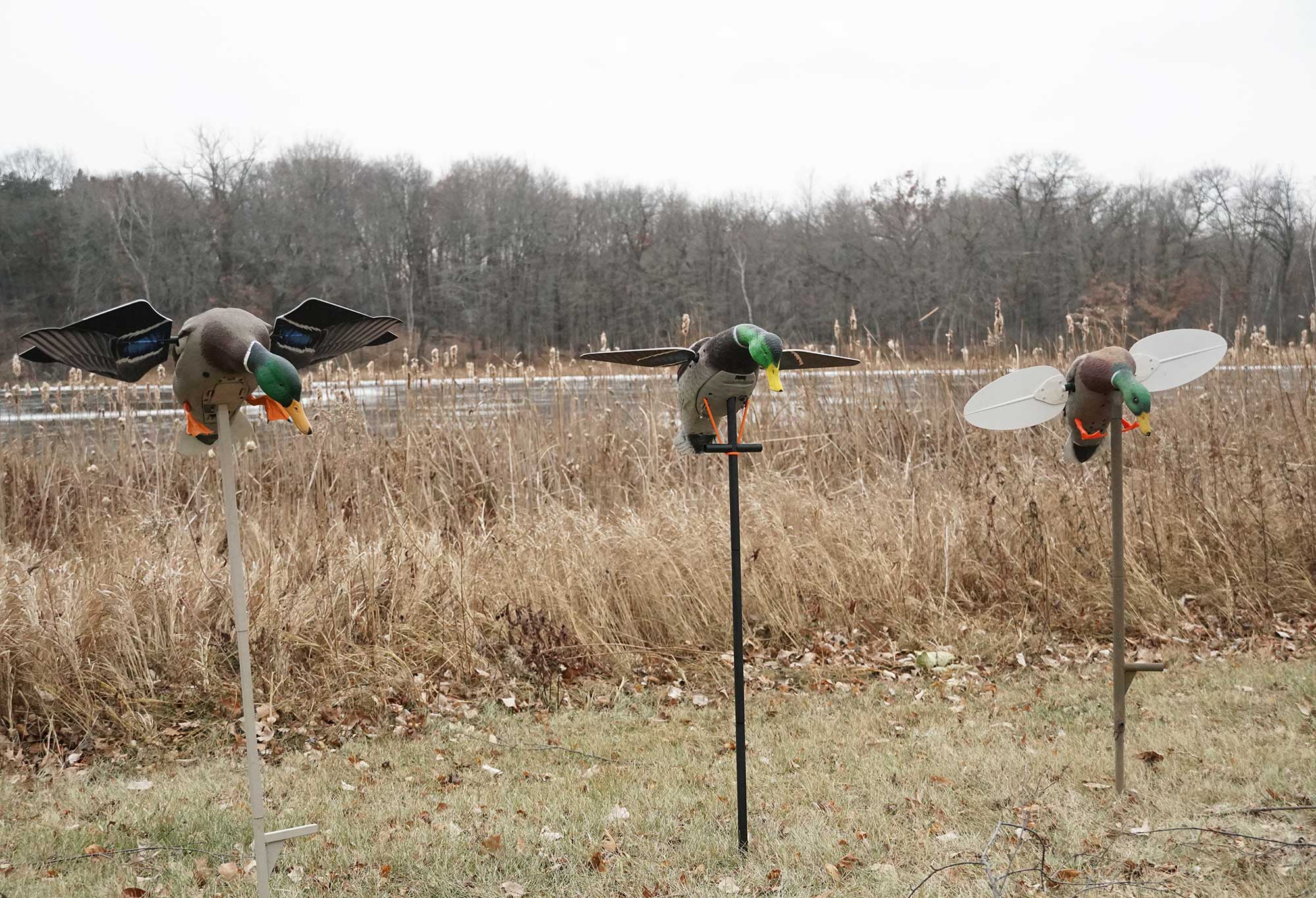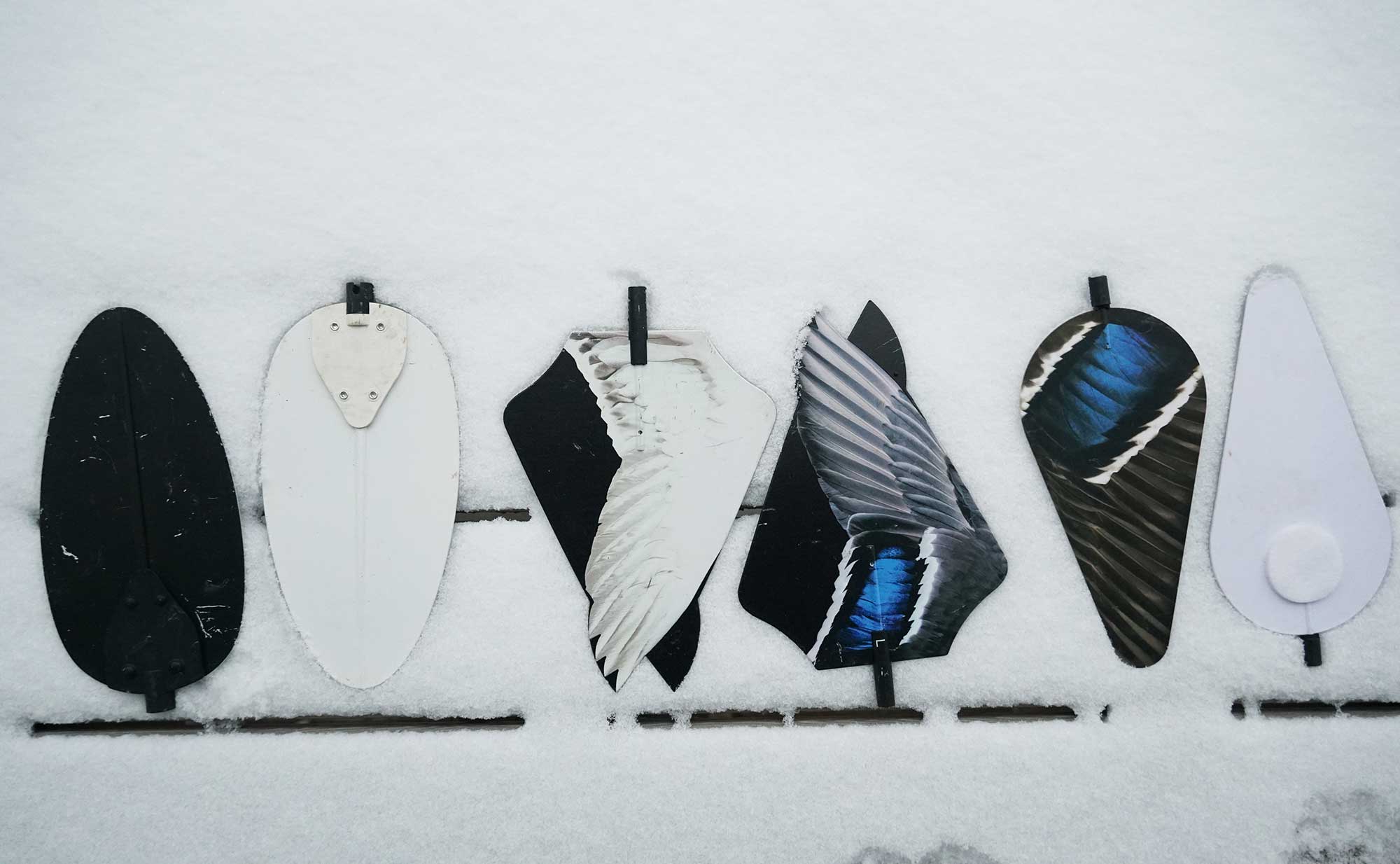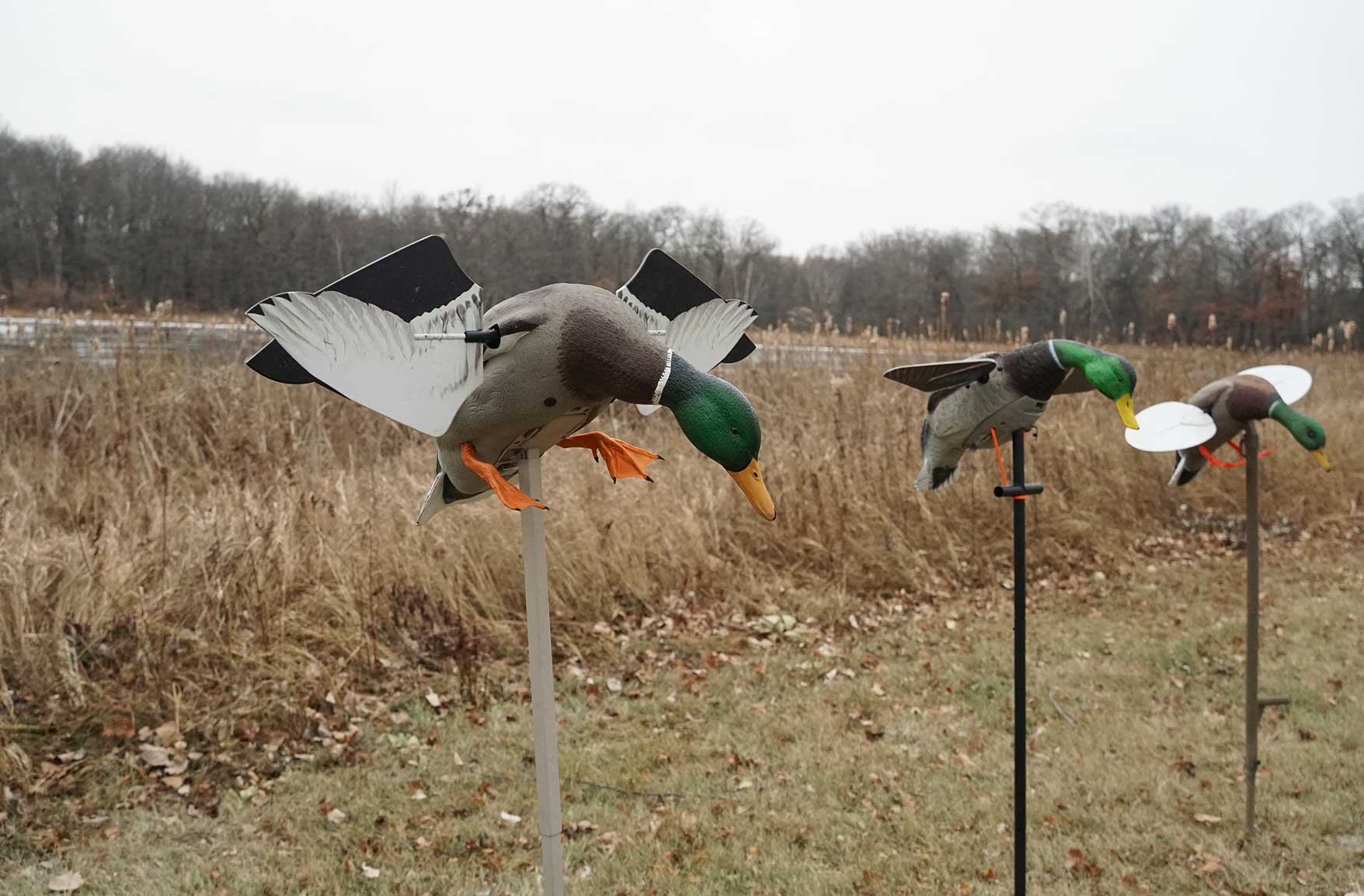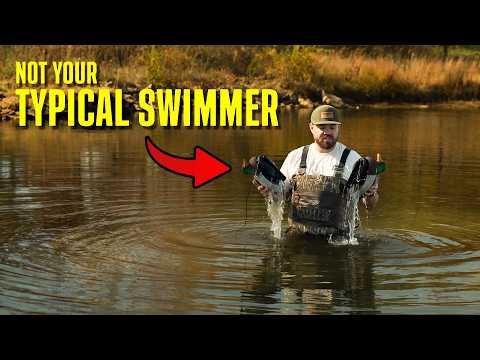The Best Motion Duck Decoys, Field Tested and Reviewed
We may earn revenue from the products available on this page and participate in affiliate programs. Learn More ›
The lineup of best motion duck decoys is much more interesting than it used to be. Old timers used jerk cords, spinning wing decoys (which everyone just called “Mojos”), and whatever homemade contraptions they could rig up in order to add some movement to their decoy spreads.
Today, duck hunters can run a variety of name brand spinners, ripplers, swimmers, and splashing decoys. The result is the ability to build an ultra-realistic decoy spread that can draw ducks from a distance, even in calm conditions.
On the downside, motion duck decoys are expensive and some of them are finicky in field conditions. Batteries die, pumps get clogged, and wires get jostled loose during wavy boat rides. In some situations, motion decoys are more trouble than they’re worth. But in others, they’re invaluable.
To separate the worthwhile products from the gimmicks, I hunted with a variety of the top motion decoys on the market through my 2024 duck season. These are the products that I’ll be hunting with again next season:
- Best Spinning Wing Decoy: Mojo Mallard Drake
- Best Spinning Wing Value: Lucky Duck HD
- Spinner with the Most Unique Action: Avian-X Powerflight Mallard
- Best Rippling Decoy: Avian-X Power Shaker
- Best Splasher: Higdon Pulsator Pro
- Best Subtle Movement: Mojo Mallard Machine
- Best Swimmer: Avian-X Power Swimmer
How I Tested the Best Motion Duck Decoys

I tested this roster of decoys by hunting my ass off during the 2024 duck season. I integrated each of these decoys into my spread and used them during hunting situations where they could thrive. All decoys in this test traveled to hunts in North and South Dakota and spent plenty of days on the water in my home state of Minnesota.

I did not baby these decoys. They got knocked around in my truck and boat. They were exposed to road dust, rain, and mud. I left the spinning wing decoys outside for a week in late October where they were showered in multiple rainstorms. At the very end of the duck season, I ran a battery test with the spinning wing decoys on a snowy December day. I charged them up and then I turned them on in my yard and let them run until the batteries died. You’ll see their individual run times published below.

Best Motion Duck Decoys: Reviews & Recommendations
Best Spinning Wing Decoy: Mojo Mallard Drake
Pros
- Bigger wings create most flash
- Large motor and fast spinning action
- Heavy-duty metal wings and stake
- Runs quietly
Cons
- Wing angle is at an exaggerated tilt
- Pricey
Key Features
- Tested Run Time: 10 hours
- Weight: 5.52 pounds
- Super simple controls
- Remote controlled with intermittent and constant settings
- Aluminum wings
- Price: $200
Mojo is the OG of spinning wing decoys, and their latest product, called simply the Mojo Mallard Drake, is a bit of a throwback to those first robo ducks. The most notable thing about this spinner is the large profile of the aluminum wings. The Mojo decoy creates noticeably more flash than both the Lucky Duck and Avian-X spinning wing decoys. I think that’s a good thing.
There are many times when I won’t run a spinning wing decoy, but when I do, I want maximum visibility, which the Mojo offers in spades. The upgraded motor spins those black and white wings quickly, creating a good amount of vibration in the unit. Interestingly, even with the vibration, I found the Mojo to be quieter than the Avian-X spinner. I’m not sure that the clicking of a spinner has ever spooked birds, but it is an unnatural sound that I prefer to avoid on a calm, quiet morning.
I also like that the Mojo Mallard comes with a sturdy support pole, which I had no problem burying deep into frozen ground. Keeping with that theme of durability, the decoy has a wiring system that allows you to connect the battery directly to the motor if you’re having issues with the standard connection (which I never did).

The body of the decoy looks far more realistic than previous versions, but it’s still not as realistic as the Avian-X deke. However, I don’t think body realism matters all that much in this type of decoy. What draws birds in is the flashing/spinning motion. So even though both the Lucky Duck and Avian-X have realistic-looking wings, (when stationary) I prefer the flash of the Mojo’s solid black and white wings. One nitpick is that the black paint on the wings is already starting to chip off after one season, but that’s nothing a coat of matte black spray paint can’t fix.
My only real critique of this decoy is that I think the angle of the body position is too dramatic, making the wing angle too steep. Mojo says this is an anatomically correct “steering” position of a landing mallard. But to my eye, when mallards flutter their wings before touching down, they are usually straight up and down (at least when close to the water). While hunting I solved this by angling the stake a little so that the wings were more parallel to the water. Did this have an impact on the ducks? I have no idea, but it made me feel better about how the decoy looked in the spread. I shot plenty of ducks over it too.
Best Value Spinning Wing Decoy: Lucky Duck HD
Pros
- Long-lasting battery
- Affordable price
- Very quiet
Cons
- Small wings
- More complicated remote setup
Key Features
- Tested Run Time: 23 hours
- Weight: 3.93 pounds
- Lithium ion battery
- Eva plastic body
- Remote controlled with constant and intermittent settings
- Magnetic wings
- Price: $120
If you want an affordable spinning wing decoy that will run for multiple hunts without a recharge, then the Lucky Duck HD is the perfect choice. In my backyard testing this decoy ran for 23 hours, which is about three times as long as the Avian-X spinner. It was also the cheapest spinner in the test, and it proved to be the quietest. It’s also the lightest spinner, which is a consideration if you’re a walk-in hunter.
This version of the Lucky Duck spinner has more durable plastic wings (compared to the old models) that are magnetized to lock into the body of the decoy.

It’s worth pointing out that Lucky Duck has a new upgraded spinner which they call the XHDI. The newest version has solid black and white wings that always stop with the black side up (so they don’t spook geese). I can see this being useful for field hunters who do a lot of mallard/goose combo hunts. But this new version will cost you an extra $80. For the best value, I’d stick with the more affordable HD model.
My main critique of this decoy is that it has smaller wings and less flash than the other two spinners in the test (I realize that some hunters may prefer that more subtle flash, and for them this deke would be a great choice). There’s also a bit more complicated setup required for the remote system with this decoy — I actually had to crack open the directions, which was not required with other models.
Spinner with the Most Unique Action: Avian-X Powerflight Mallard
Pros
- Ultra-realistic body
- Unique wing design and action
- Smaller, lighter battery
Cons
- Shorter battery life
- More noise
- Smaller stake
Key Features
- Tested Run Time: 8 hours
- Weight: 4.39 pounds
- Lithium ion battery
- Remote controlled with constant and intermittent settings
- “Angel wing” design
- Price: $180
If you think that ducks in your area have been burned out on traditional spinning wing decoys, then you should give the Avian-X Powerflight mallard serious consideration. This decoy has a unique wing design that more closely resembles a landing mallard. When the wings are spinning you can clearly see the angel wing shape of a flapping mallard, compared to the basic white flash of other decoys. On top of that, this decoy has an incredibly lifelike body. It was hands down the most realistic looking carve out of the three spinner decoys in my test.

However, the Avian-X did have some flaws. Its lithium-ion battery powered the spinner for 8 hours (shortest run time in the test) even though Avian-X says it will run for 16 hours. The decoy did make a noticeable clicking noise when spinning. I doubt this would flare birds on a windy day, but it is an unnatural sound and was noticeable in the blind on calm mornings. Lastly, the stake was the flimsiest of the three and it also got stuck to the decoy in my testing. I had to put the deke on the ground and hold it with my foot to separate it from the stake.
But still, those quibbles would be worth overlooking if you wanted to give pressured late-season ducks a slightly different look from what they’ve seen in previous years.
Best Rippling Decoy: Avian-X Power Shaker
Pros
- Creates realistic, subtle ripples in the water
- Fits in perfectly with a water spread
- Adds motion without potentially spooking birds
Cons
- Pricey (you’ll want to run several in a spread)
- Not rechargeable
Key Features
- Foam filled body
- 10-hour run time (advertised)
- Preening and feeding body postures
- Powered by four AA batteries
- Available in three species (mallard, pintail, black duck)
- Price: $80
I knew the Power Shaker decoys were effective when they faked out my veteran duck dog. The first time I hunted with them, I sent old Otie dog on a retrieve and she swam right toward the ripples being made by the decoy. After a few more productive hunts the Power Shakers became my new favorite decoys of the year. Now, I bring them on every water hunt.
Two to four of these shakers in a spread of two dozen decoys really does help add realism. They are especially useful on small waters during calm days. That subtle, but noticeable, ripple in the spread is sometimes all you need to get ducks to commit. I honestly believe that I killed ducks over these decoys that I wouldn’t have otherwise been able to coax into range.

The Power Shakers have a simple on/off switch and are fueled by four AA batteries. I wish they were rechargeable with an indicator showing how much battery life they had left, but alas, we live in an imperfect world. I now carry a couple extra AA batteries in my blind bag in case one of these shakers dies during a hunt.
Best Splasher: Higdon Pulsator Pro
Pros
- Generates lots of commotion in the spread
- More durable than previous models
- Upgraded charging port
Cons
- Sticky on/off button
- Limited run time
Key Features
- Foam filled body
- 7-hour run time (advertised)
- Can run in salt water
- Runs in 6 inches of water
- Price $130
The Higdon Pulsator has been out for many years, but the Pro model is by far the best version yet. Previous generations had external wires connecting the battery to the bilge pump and years ago there was a recall related to charging issues with these decoys.
But no more. The Pulsator Pro has no external wires. The charging port is magnetized and incredibly simple to use. The on/off switch has been upgraded to a hefty orange tab. All in all, the Pulsator is more durable and easier to use than ever before. And it still creates that wonderful splashing action in the spread that mimics feisty, feeding mallards.

These decoys are most useful in bigger spreads, especially in the timber or on big water. During my hunts in 2024, I was impressed with how the pulsator was able to handle mucky water without ever bogging down. My only qualms were that a 7-hour run time is a bit short (compared to other motion decoys) and the on/off switch on my decoy got sticky several hunts in. I had to use the edge of my boat to force it to turn on.
Best Subtle Movement: Mojo Mallard Machine
Pros
- Mimics realistic bobbing motion of a feeding mallard
- Adds noticeable but subtle motion
- Simple operations
Cons
- Pricey
- No remote
Key Features
- Screen prevents debris from entering motor
- 8-hour run time (advertised)
- Motor drives it to bob and twist
- Price: $190
If you like the idea of a butt-up motion decoy but don’t want the aggressive splashing of the Higdon Pulsator, then Mojo’s Mallard Machine might be the right choice for you. This decoy bobs and twists in the water, creating ripples but not large splashes.

This decoy has a rather large profile, so ducks will see it as they fly over. It will definitely take up some space in your decoy bag, but that will be worth it for the motion it produces.
Best Swimmer: Avian-X Power Swimmer
Pros
- Adds subtle swimming decoy to the spread
- Won’t spook ducks
- Incredibly lifelike body
Cons
- Gets bogged down in the muck
- No easy access to on/off switch
- Finicky in weeds
Key Features
- Foam filled decoy
- 8-hour run time (advertised)
- Rechargeable lithium ion battery
- Intermittent and constant swimming modes
- Available in three species (mallard, pintail, gadwall)
- Price: $170
The concept for this decoy is perfect. Among a spread of stationary dekes, the simmer will stand out and draw birds closer. I could see myself running three or four of these decoys in certain situations. However the Avian-X Power Swimmer did have some issues on the water.

While hunting potholes in North Dakota, I noticed the decoy got hung up easily in weeds. No matter, I started setting it on the outside of the spread in more open water. However it wasn’t long before mud and muck worked into the filter and bogged down the motor. I cleaned the decoy and got it running again, but noticed that even when out of the water, the motor kept running.
This decoy is water activated. The motor starts when it’s submerged and shuts off when removed from the water. However even when out of the water the motor in my decoy kept pumping. To access the on/off switch you have to unscrew the plastic base. This is a bit of a pain when you’re hustling to get decoys placed in the dark or when you’re picking up after a long hunt.
Still, I can see the value of this decoy. If you hunt mostly open water then this would be a great addition to your spread. If you hunt mostly mucky marshes and sloughs, then I’d spend your money on the other motion decoys in this review.
Read Next: The Best Duck Decoys
How to Choose the Best Motion Duck Decoys

If you watch a big flock of ducks sitting on the water, you’ll see them swimming, splashing, diving to feed, and regularly flapping their wings. You’ll never see a big flock of mallards sitting perfectly still on the water for any length of time.
That’s why when you’re setting a realistic decoy spread, it’s critical to incorporate motion. Here’s what you need to consider with each type of motion duck decoy.
Spinners
These are probably the most popular motion decoys on the market and they mimic the flashing, fluttering wings of ducks landing or flapping on the water. But because spinners are so popular, ducks in some areas can become conditioned to them. Spinners are most effective on clear, sunny days. They’re also incredibly effective during field hunts. When you’re hunting pressured birds on small waters during overcast days, it’s often a good idea to pull the spinners from the spread.
Rippling Decoys
These decoys vibrate in the water and make a ring of ripples in the spread. They offer a more subtle approach to motion and are perfect in small waters on calm days. For example, if you plan to run a small spread of 12 to 18 decoys in a cattail slough, it would be a good idea to make sure to have two or three rippling decoys in the mix.
Splashing Decoys
Feeding ducks create a lot of splashing. On sunny days, the reflection of that splashing water can be seen from a long distance. And that’s exactly what decoys like the Higdon Pulsator mimic. I like to put a splashing decoy in the densest part of the spread so that all the decoys around it swirl in its wake.
Swimming Decoys
These decoys move around the spread slowly, mimicking ducks paddling around each other. This type of decoy can easily get hung up on vegetation and stuck in the muck, so they’re most useful on the outer edges of the spread in open water.
Read Next: How to Decoy Ducks
Final Thoughts on the Best Motion Duck Decoys

All good spreads have some motion. That could be the wind or current naturally shifting traditional floater decoys, or it could be a series of battery-powered ripplers, splashers, and spinning wings. The key is understanding that different conditions call for different decoy setups. Throwing out two dozen decoys and one spinning wing is not going to work every time. So enhance your spread with a few of these other motion duck decoys and experiment with different combinations under different conditions. Before long you’ll have a fine-tuned rig, no matter what the weather throws at you.
- Best Spinning Wing Decoy: Mojo Mallard Drake
- Best Spinning Wing Value: Lucky Duck HD
- Spinner with the Most Unique Action: Avian-X Powerflight Mallard
- Best Rippling Decoy: Avian-X Power Shaker
- Best Splasher: Higdon Pulsator Pro
- Best Subtle Movement: Mojo Mallard Machine
- Best Swimmer: Avian-X Power Swimmer
The post The Best Motion Duck Decoys, Field Tested and Reviewed appeared first on Outdoor Life.
Source: https://www.outdoorlife.com/hunting/best-motion-duck-decoys/




